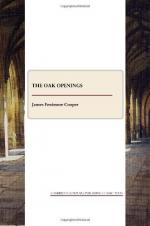In less than half an hour the whole band was collected around Castle Meal, distant, however, beyond the range of a rifle. The different parties, as they arrived, announced their presence by whoops, which were intended to answer the double purpose of signals, and of striking terror to the hearts of the besieged; the North American Indians making ample use of this great auxiliary in war.
All this time no one was seen in or about the fortified hut The gate was closed, as were the doors and windows, manifesting preparations for defence; but the garrison kept close. Nor was Peter to be seen. He might be a prisoner, or he might not have come in this direction. It was just possible that he might be stealing up to the building, to get a nearer view, and a closer scout.
Indian warfare is always stealthy. It is seldom, indeed, that the aboriginal Americans venture on an open assault of any fortified place, however small and feeble it may be. Ignorant of the use of artillery, and totally without that all-important arm, their approaches to any cover, whence a bullet may be sent against them, are ever wary, slow, and well concerted. They have no idea of trenches—do not possess the means of making them, indeed—but they have such substitutes of their own as usually meet all their wants, more particularly in portions of the country that are wooded. In cases like this before our present band, they had to exercise their wits to invent new modes of effecting their purposes.
Bear’s Meat collected his principal chiefs, and, after a considerable amount of consultation, it was determined, in the present instance, to try the virtue of fire. The only sign of life they could detect about the hut was an occasional bark from Hive, who had been taken within the building, most probably to protect him from the bullets and arrows of the enemy. Even this animal did not howl like a dog in distress; but he barked, as if aware of the vicinity of strangers. The keenest scrutiny could not detect an outlet of any sort about the hut. Everything was tightly closed, and it was impossible to say when, or whence, a bullet might not be sent against the unwary.
The plan was soon formed, and was quite as rapidly executed. Bough of the Oak, himself, supported by two or three other braves, undertook to set the buildings on fire. This was done by approaching the kitchen, dodging from tree to tree, making each movement with a rapidity that defeated aim, and an irregularity that defied calculation. In this way the kitchen was safely reached, where there was a log cover to conceal the party. Here also was fire, the food for dinner being left, just as it had been put over to boil, not long before. The Indians had prepared themselves with arrows and light wood, and soon they commenced sending their flaming missiles toward the roof of the hut. Arrow after arrow struck, and it was not long before the roof was on fire.




